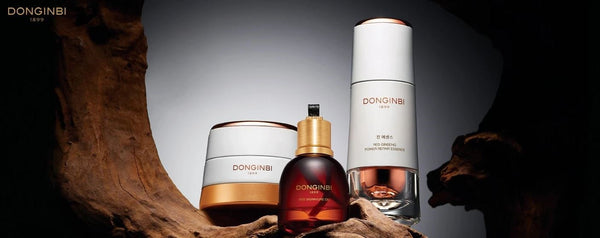Korean Ginseng for Skin Care Part I
What is Korean Ginseng?

To start with the basics—ginseng is a slow-growing perennial plant with fleshy roots and belongs to the genus Panax of the family Araliaceae.
The word “ginseng” itself comes from the Chinese word rénshēn (Rén means person, while shēn means plant root since the root looks like a human figure). Also, the genus name Panax means “all-healing” in Greek (it was so named because Carl Linnaeus was aware of its wide use in Chinese medicine).
Ginseng has been used in traditional medicine in eastern Asia for over 2000 years, where it is taken orally (mostly via tea and tinctures) to treat various diseases. But many people don’t know that it has also been used in topical applications to heal wounds and treat skin inflammation.
Korean red ginseng, in particular, has played an important role in traditional Asian medicine since ancient times and is being used more and more in Korean skincare products.
White Ginseng Vs. Red Ginseng

The ginseng used in traditional Korean medicine and Korean skincare products is 4-6 + years of age (following cultivation) and can be divided into two types: white ginseng and red ginseng.
White ginseng is generally 4-6-year-old ginseng root that has been peeled and dried without heating. The moisture content of white ginseng is typically low.
Korean red ginseng, on the other hand, is 6 + year old ginseng root that has been steamed first for hours and then dried (giving it a red color). The moisture content of red ginseng is typically a little higher than white ginseng.
Both white and red ginseng are believed to have immuno-modulatory, anti-inflammatory, antioxidant, and anti-atopic properties (see more about this in the section below). However, red ginseng is thought to have more potent pharmacological properties due to the chemical changes that occur during the steaming process (antioxidant-like substances are increased and catabolic enzymes are inactivated).
In other words, red ginseng is preferred over white ginseng since it appears to be more effective.
The Active Constituents Of Ginseng
So what actually makes Korean red ginseng such a powerful herb, leading to its widespread use in traditional Chinese and Korean medicine, and now, its use in skin care products too?
About 200 compounds have been isolated from the Korean species of ginseng (also called Panax ginseng), including many biologically active ingredients such as ginsenosides, polysaccharides, phytosterols, peptides, polyacetylenes, fatty acids, and polyacetylenic alcohols.
Out of these compounds, ginsenosides (steroid-like saponins) are believed to be the major biologically active components of ginseng (and the most widely studied). More than 100 ginsenosides are known to exist and a total of 38 ginsenosides have been isolated from Panax ginseng. Out of these, 3 are unique to red ginseng.
I would love to go into further detail about ginsenosides and their pharmacological effects, but the biochemistry would be way too advanced (and perhaps boring) for this article. Just know that these are most likely the compounds that are responsible for many of the benefits that ginseng has.
It is also believed that other major bioactive constituents of Panax ginseng (namely polysaccharides and phenolic compounds) have strong antioxidant effects.
Donginbi 1899 Skin Products
With the above concerns in mind, consider taking a natural supplement to help your skin.

For the best Korean red ginseng, try Cheong Kwan Jang ginseng supplements and change your life!
 Stamina
Stamina Energy
Energy Immunity
Immunity Antioxidant
Antioxidant Beauty
Beauty Fitness
Fitness Blood Circulation
Blood Circulation Liver & Heart
Liver & Heart Bones & Joints
Bones & Joints Eye & Brain
Eye & Brain Digestion
Digestion Relax & Sleep
Relax & Sleep For All
For All Men's Health
Men's Health Woman's Health
Woman's Health Kid's Health
Kid's Health Jar
Jar Stick
Stick Pouch
Pouch Root & Slices
Root & Slices Shot
Shot Pill
Pill Tea & Powder
Tea & Powder Candy
Candy

 Our Brand
Our Brand Korean Red Ginseng
Korean Red Ginseng Premium Ingredient G1899
Premium Ingredient G1899





